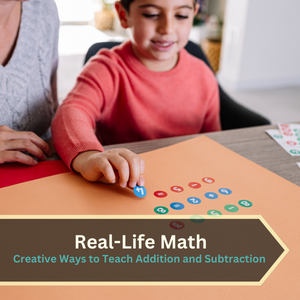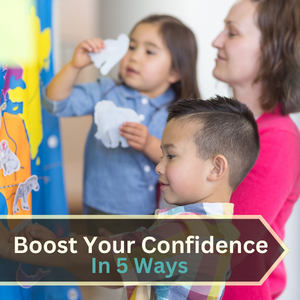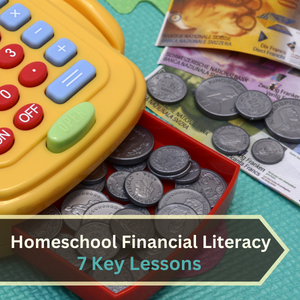Understanding addition and subtraction is crucial in the early stages of a child’s education. These basic math skills are the building blocks for more complex mathematical concepts children will encounter as they grow. As part of your homeschooling curriculum, how can we devise ways to help kids find the learning of essential skills engaging and effective?
The Importance of Practical Math Learning in Early Childhood
Addition and subtraction are about numbers and understanding relationships and quantities. Practical math learning helps children see the relevance of math in their everyday lives. By integrating real-world examples into teaching, we can make these concepts more intuitive and meaningful.
Real-world examples provide context to mathematical concepts, making them easier to grasp. Practical math learning allows children to apply addition and subtraction in situations they encounter daily, reinforcing their understanding and making math more relatable.
Incorporating Addition and Subtraction into Daily Routines
One of the best ways to teach addition and subtraction is to weave these concepts into everyday activities. This approach not only helps reinforce math skills but also demonstrates how math is a practical part of life.
Simple tasks like meal preparation, shopping, or even laundry sorting can become practical math learning opportunities. For instance, children can help measure ingredients while cooking, which involves addition and subtraction.
Making Math a Natural Part of a Child’s Day
Incorporating math into daily routines can help children develop a positive attitude toward math. It becomes a natural and enjoyable part of their day rather than a separate and daunting subject.
Making Change: A Practical Approach to Addition and Subtraction
Handling money during homeschooling exercises is an excellent way to help your child learn practical early math in action. Making change involves addition and subtraction and is a skill children will use throughout their lives.
Explain the basics of currency and the process of making change. Use real or play money to create scenarios where children need to calculate the correct amount of change to give back.
Creating Scenarios Involving Money
Set up a pretend store or a lemonade stand where children can practice being customers and shopkeepers. This role-playing activity is fun and practical for teaching addition and subtraction.
- Pretend Store: Set up a pretend store at home using items from around the house. In your homeschooling lessons, label each cup or household item with a price tag to teach measurement and money value. Give your child play money or real coins and bills to use as currency. We came across this money on Amazon that looks like real money. It has been a great way to give them a real representation of money. As the shopkeeper, you can help your child select items to “purchase” and teach them how to count out the correct amount of money for each item. When they give you more than the exact price, show them how to calculate and make changes. This activity teaches basic money-handling and math skills and encourages imaginative play.
- Price Comparison Game: Turn a grocery shopping trip into a learning experience with a price comparison game. Give your child a small budget and a list of items to find. Challenge them to compare prices of different brands or sizes and choose the best deals within their budget. Discuss concepts like unit pricing and sales. This activity helps children understand the value of money, budgeting, and making smart purchasing decisions.
- Money Jar Sorting and Counting: Collect a jar of mixed coins and spread them on a table. Please have your child sort the coins by type (pennies, nickels, dimes, quarters) and then count how much each type they have. Next, have them calculate the total amount of money in the jar. This simple activity teaches coin recognition, addition, and basic counting skills. To make it more challenging for older children, you can introduce concepts like saving for a goal or budgeting for a small purchase.
Dividing Snacks and Treats: Learning through Sharing
Sharing snacks or treats among friends or family is an excellent way to teach practical math skills, especially subtraction and division.
During homeschooling lessons, when dividing a pizza or measuring a cup of cookies, ask children to calculate how many pieces each person gets. This simple activity helps them understand the concept of division, which is closely related to subtraction.
These activities not only teach math but also encourage sharing and fairness. Children learn to consider others while practicing their math skills, making the learning experience more holistic and meaningful.
Fun with Grocery Shopping: A Real-World Math Experience
Homeschool grocery shopping can offer numerous opportunities for practical math learning, especially teaching addition and subtraction to young children.
Using Grocery Shopping to Teach Math
During grocery shopping trips, involve children in calculating the total cost of items, comparing prices, or determining the change due after payment. This provides them with ways to practice addition and multiplication and introduces them to budgeting and price comparison concepts.
Create a homeschool shopping list with your child and have them multiply the prices by two as you shop. Challenge older children to stay within a budget or find the best deals. This makes the shopping experience both educational and engaging.
Educational Games and Toys for Addition and Subtraction
Games and toys can make learning addition and subtraction enjoyable. They offer a playful way to reinforce math concepts and encourage active participation.
Board Games and Card Games for Math Practice
Recommend educational board games and card games that focus on basic math skills. Games that involve counting, adding, and subtracting can be great tools for practicing math in a fun and competitive environment.
- Number Park – Addition & Subtraction Math Games for Kids: “Number Park” is an engaging and interactive math game designed to help kids practice and improve their addition and subtraction skills. The game features a fun park-themed setting where children can explore various attractions and activities incorporating basic math problems. Through playful challenges and exercises, kids learn and reinforce their understanding of addition and subtraction in an enjoyable and educational environment.
- Auvewilo Wooden Math Board, Addition and Subtraction: The “Auvewilo Wooden Math Board” is an educational tool that combines hands-on learning with basic math concepts. Made from durable wood, this board game includes colorful blocks representing numbers and mathematical symbols for addition and subtraction. Children can arrange the blocks to solve math problems, enhancing their number recognition and arithmetic skills. This tactile and visually appealing game is an excellent way for young learners to develop a foundational understanding of math.
- Yuka Champs Smart Math Games for Kids: “Yuka Champs Smart Math Games for Kids” is a collection of math-focused games designed to make learning fun and interactive. These early math games cover a range of mathematical concepts, including addition, subtraction, multiplication, and division, adapted to fit various age groups and skill levels in a homeschool environment. The games aim to boost kids’ confidence in math through enjoyable and stimulating activities that challenge their problem-solving and critical-thinking abilities.
Choosing Toys That Enhance Math Skills
Select toys that naturally incorporate math, such as puzzles that involve number matching or building sets that require counting pieces. In the process of homeschooling, these toys can entertain and strengthen young children’s foundational math skills.
Storytelling and Math: Creating Addition and Subtraction Tales
Storytelling can be creatively incorporated into homeschooling as a powerful tool in teaching early math. It can turn abstract concepts into relatable stories that captivate young minds.
Using Stories to Illustrate Math Problems
Create simple stories or scenarios that involve addition and subtraction problems. For example, tell a story about animals sharing food or a builder who needs to add or subtract materials. The approach of using measurement helps young children visualize math problems, making them more engaging.
Encouraging Imagination and Math Learning
Invite young children to create their own math stories during homeschooling activities as an early math skill. This homeschool activity nourishes creativity while bolstering math skills, making learning a more personal and enjoyable experience for young children.
Outdoor Activities: Exploring Math in Nature
Taking math learning outdoors can provide a refreshing change of scenery and introduce children to practical math applications in nature.
Counting Steps and Adding Objects Found in Nature
Go on a nature walk, count your steps, gather leaves, or collect stones. Then, use these items to practice addition and subtraction. This activity teaches math and encourages exploration and appreciation of the natural world.
Connecting Math Learning with Physical Activity
Outdoor math activities can be combined with physical exercises, such as playing hopscotch with math problems or setting up an obstacle course with math challenges. This holistic approach benefits both the mind and body.
Creative Arts and Crafts: Visualizing Math Concepts
Arts and crafts can effectively teach math, as they allow children to visualize and create representations of math concepts.
Arts and Crafts Projects for Math Learning
For homeschooling activities, propose projects like creating number collages, using cups for liquid measurements, and making a paper number line. These activities help children understand math concepts tangibly and artistically.
Enhancing Spatial Reasoning and Artistic Expression
These projects teach math and develop spatial reasoning and artistic skills. They offer a multi-sensory approach to learning, catering to different learning styles and preferences.
Ready to make math learning fun and practical for your child? Try these real-world activities and games to teach addition and subtraction effectively and enjoyably!
For more amazing tips, check out our other posts at Happy Pages Homeschool.





One Reply to “Fun Ways to Develop Early Math Skills for Young Children with Real-World Examples”